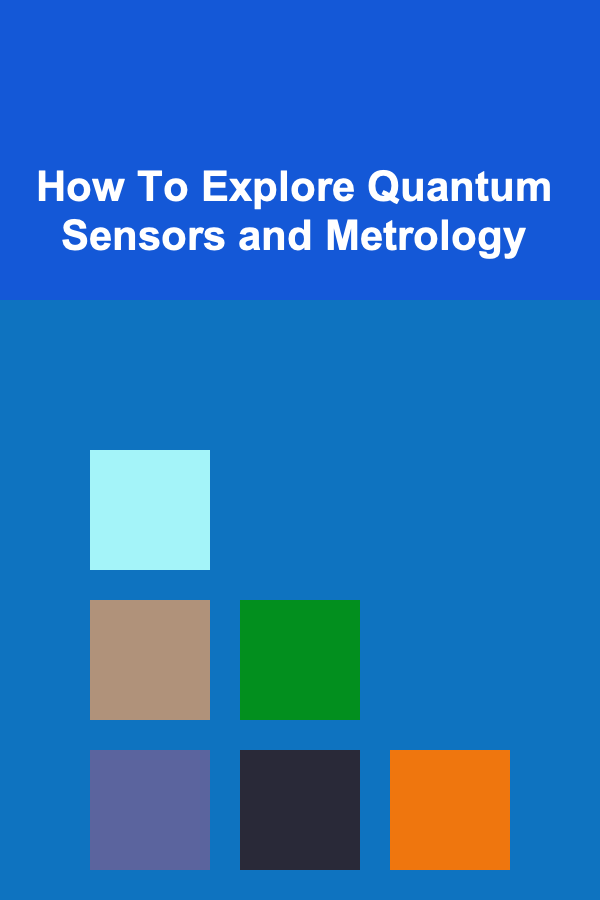
How To Explore Quantum Sensors and Metrology
ebook include PDF & Audio bundle (Micro Guide)
$12.99$8.99
Limited Time Offer! Order within the next:

Quantum sensors and metrology are emerging fields that combine the power of quantum mechanics with the precision of measurement techniques to push the boundaries of our understanding of the physical world. Quantum sensors exploit quantum properties such as superposition, entanglement, and quantum coherence to enhance sensitivity and precision in measuring physical quantities like time, magnetic fields, temperature, and acceleration. This article explores how to delve into the fascinating world of quantum sensors and metrology, with a focus on theoretical foundations, practical applications, and cutting-edge advancements.
Introduction to Quantum Sensors and Metrology
Quantum metrology refers to the use of quantum mechanics in the field of measurement. By leveraging quantum states, quantum metrology can achieve measurement precision that surpasses classical limits. In the classical world, the precision of measurements is limited by noise, but quantum effects allow for the development of sensors that can surpass these classical boundaries, offering unprecedented accuracy and sensitivity.
Quantum sensors, on the other hand, are devices that utilize these quantum properties to measure physical quantities. For instance, by measuring the behavior of quantum states under the influence of an external field, quantum sensors can be used to measure parameters such as magnetic fields, gravitational forces, time, and temperature with high precision.
Core Principles of Quantum Sensors
To explore quantum sensors, it's essential to understand the quantum principles that underpin their operation:
2.1 Superposition
Superposition is the ability of quantum systems to exist in multiple states simultaneously. This property allows quantum sensors to measure multiple possibilities at once, enhancing their sensitivity and accuracy. For example, a quantum sensor could simultaneously sense multiple frequencies or different magnetic field strengths, leading to richer, more detailed measurements.
2.2 Entanglement
Entanglement is a phenomenon where two or more quantum particles become correlated in such a way that the state of one particle is dependent on the state of the other(s), no matter how far apart they are. Entanglement is particularly useful in quantum metrology, as it can allow for highly precise measurements by exploiting the correlations between entangled particles. This can be applied in systems such as quantum interferometers, where entangled states improve the resolution and sensitivity of measurements.
2.3 Quantum Coherence
Quantum coherence refers to the ability of a quantum system to maintain its quantum state over time. Quantum sensors often rely on coherent quantum states to preserve and enhance measurement accuracy. Maintaining coherence over longer periods is crucial for applications like quantum clocks, where temporal precision is vital.
2.4 Quantum Interference
Quantum interference arises from the wave-like nature of quantum particles. When two or more quantum states combine, they can interfere with each other in a way that enhances or diminishes the measured signal. This principle is fundamental in many quantum sensing techniques, including atomic clocks and interferometric sensors.
Key Technologies in Quantum Metrology
Quantum metrology uses a range of advanced technologies, many of which have been developed or refined in recent years. Some of the key technologies include:
3.1 Quantum Optics
Quantum optics deals with the behavior of light at the quantum level. This field has been central to developing quantum sensors, such as optical atomic clocks, which rely on the quantum properties of light and atoms to measure time with extraordinary precision. Quantum optics also enables the development of quantum-enhanced imaging and measurement techniques.
3.2 Atomic Clocks
Atomic clocks are perhaps the most well-known application of quantum metrology. These clocks rely on the precise transitions between energy levels in atoms (such as cesium or rubidium) to keep time. By exploiting quantum coherence, atomic clocks can achieve accuracy levels that are orders of magnitude higher than classical mechanical clocks. The precision of atomic clocks has far-reaching implications, from GPS systems to fundamental tests of physics.
3.3 Quantum Interferometry
Quantum interferometers exploit quantum interference to measure small changes in physical quantities such as distance, gravitational waves, or magnetic fields. One of the most prominent applications of quantum interferometry is the detection of gravitational waves, as demonstrated by the Laser Interferometer Gravitational-Wave Observatory (LIGO). Quantum-enhanced interferometers can improve sensitivity, enabling detection of weaker signals and offering a more detailed understanding of the universe.
3.4 Magnetometers
Quantum magnetometers use quantum properties to measure magnetic fields with extraordinary precision. For example, nitrogen-vacancy (NV) centers in diamonds can detect magnetic fields at the nanoscale, making them useful for biological and materials science applications. Similarly, quantum Hall effect-based magnetometers offer high precision in measuring extremely small magnetic fields.
3.5 Gravitational Wave Detectors
Gravitational wave detectors, such as LIGO and Virgo, measure ripples in spacetime caused by violent astrophysical events like black hole mergers. These detectors rely on quantum sensors to achieve the extraordinary sensitivity required to detect these faint signals. Quantum metrology plays a crucial role in improving the sensitivity of gravitational wave detectors by minimizing noise and enhancing measurement precision.
3.6 Quantum Thermometry
Quantum thermometry involves measuring temperature using quantum states. These sensors take advantage of quantum effects like the energy level splitting in atoms or molecules, which are temperature-dependent. Quantum thermometry offers significant improvements over traditional thermometers, especially at very low or very high temperatures.
Applications of Quantum Sensors
Quantum sensors have broad applications in various fields, ranging from fundamental physics to practical technologies. Some of the key areas where quantum sensors are making an impact include:
4.1 Fundamental Physics and Tests of Nature
Quantum sensors provide an unprecedented level of precision that is crucial for testing the fundamental laws of nature. For example, they can be used to test the limits of general relativity, search for dark matter, and study the behavior of quantum fields. The precision of quantum sensors allows for more accurate measurements of constants like the gravitational constant or the fine-structure constant, potentially leading to new insights in theoretical physics.
4.2 Navigation and Geodesy
Quantum sensors, particularly atomic clocks, have revolutionized navigation systems like GPS. By providing highly accurate time measurements, these clocks enable precise location tracking. Additionally, quantum sensors are being used in geodesy to study Earth's gravitational field, helping scientists track changes in Earth's surface, such as shifts caused by tectonic activity or sea-level rise.
4.3 Medical Imaging and Diagnostics
Quantum sensors are being used to develop novel medical imaging technologies. For example, quantum-enhanced magnetometers can detect extremely small magnetic fields produced by biological tissues. This can lead to breakthroughs in techniques like magnetic resonance imaging (MRI), providing higher resolution and sensitivity in detecting diseases such as cancer or neurological disorders.
4.4 Environmental Monitoring
Quantum sensors can be applied to environmental monitoring by measuring various parameters such as temperature, humidity, magnetic fields, and pressure with greater precision. These sensors can be used to monitor pollution levels, track climate change, and improve the accuracy of weather predictions.
4.5 Materials Science and Nanotechnology
Quantum sensors are increasingly important in materials science, where they are used to probe the properties of materials at the nanoscale. For example, quantum magnetometers can map out the magnetic properties of materials with extreme sensitivity. This has implications for developing new materials, improving the performance of electronics, and designing advanced nanotechnologies.
Challenges and Future Directions
While quantum sensors and metrology offer exciting possibilities, several challenges remain. These challenges include:
5.1 Noise and Decoherence
Quantum systems are inherently susceptible to noise and decoherence, which can degrade the precision of measurements. Researchers are working on methods to mitigate the effects of noise, such as through quantum error correction techniques and designing sensors that are more resilient to environmental disturbances.
5.2 Scalability
Many quantum sensors, particularly those based on atomic systems or entanglement, require highly controlled environments. Scaling these technologies to practical, mass-market applications is a significant challenge. Researchers are exploring ways to miniaturize quantum sensors and make them more robust and cost-effective for real-world use.
5.3 Integration with Classical Systems
Quantum sensors need to be integrated into existing classical systems for widespread adoption. This requires developing interfaces between quantum and classical technologies, such as connecting quantum sensors with classical computing systems for data analysis.
5.4 Quantum Standardization
As quantum sensors move toward commercialization, standardization becomes critical. Establishing agreed-upon protocols and performance benchmarks will ensure that quantum sensors are reliable, interoperable, and consistent across various applications.
Conclusion
Exploring quantum sensors and metrology requires a deep understanding of both quantum mechanics and precision measurement techniques. As quantum technologies continue to advance, these sensors promise to revolutionize a wide range of fields, from fundamental physics to everyday applications in medicine, navigation, and environmental monitoring. Despite the challenges that lie ahead, the potential of quantum sensors to achieve unprecedented levels of precision offers exciting opportunities for the future. By embracing quantum principles and leveraging the latest technologies, we can unlock new frontiers in measurement and exploration.

How to Arrange Furniture for Family Gatherings
Read More
How to Create a Soundproof Home Office for Better Focus
Read More
How to Maximize Your Retirement Savings with IRAs
Read More
How To Play Party Games That Don't Suck
Read More
Practicing Respect in Every Interaction
Read More
How to Bind a Quilt with a Bias Edge
Read MoreOther Products

How to Arrange Furniture for Family Gatherings
Read More
How to Create a Soundproof Home Office for Better Focus
Read More
How to Maximize Your Retirement Savings with IRAs
Read More
How To Play Party Games That Don't Suck
Read More
Practicing Respect in Every Interaction
Read More